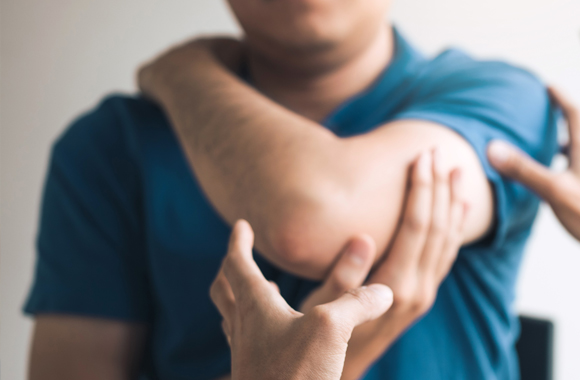Within the elbow, there are many important structures that provide support, such as:
- Ligaments: string-like tissues that connect bone to bone to help hold the tendons in place and stabilize the joints.
- Tendons: soft tissue that connects our muscles to bones and allows our limbs to move.
- Cartilage: covers the ends of connecting bones to provide fluid bending and straightening movements in a low friction environment. Cartilage also plays a role in protecting the elbow joint against any impact or stresses.

Common Elbow Conditions
The elbow is prone to several conditions. Those who participate in sports such as golf, tennis, and weight lifting are more susceptible to an elbow injury. The Motion Orthopaedics team of experts is highly qualified in treating all sorts of issues you may be experiencing pertaining to the elbow. Common elbow conditions include:
Tennis Elbow
Tennis elbow is a type of tendonitis that occurs in the outer part of the elbow. It’s sometimes called lateral epicondylitis because it can be caused by overusing tendons on the outside, or lateral side, of your upper arm near your elbow joint. Typically you get tennis elbow from repetitive motion involving gripping, lifting, or serving movements.
Golfer’s Elbow
Golfer’s elbow, sometimes referred to as medial epicondylitis, is an overuse injury that affects the muscles and tendons in your wrist, forearm, and elbow. Golfer’s elbow is caused by the repetitive motion of bending and straightening your wrist, as can happen with activities like golfing or racquetball. This repetitive motion causes small tears in the muscles and tendons around the inside part of your elbow, which leads to pain and tenderness in the forearm, stiffness of joints, and swelling.
Bicep Tear
A bicep tear is a term used to describe the break or tear of one or more tendons that connects the bicep muscle in your upper arm to your elbow or shoulder. Injuries can occur from overtraining, not warming up properly before exercising, improper form when lifting weights, or heavy overhead activities. Symptoms include pain in your upper arm and a popping sound when injured.
Cubital Tunnel Syndrome
Cubital tunnel syndrome happens when the ulnar nerve at the elbow becomes swollen, irritated, or inflamed. Cubital tunnel syndrome can be caused by overuse of the elbow, arthritis, bone spurs, and fractures or dislocations of the elbow. Those with diabetes mellitus and patients whose work involves extended periods of elbow flexion are more at risk of getting cubital tunnel syndrome.
Treatment Options for Elbow Conditions
There are many treatment options for the elbow conditions listed above. Some non-surgical treatment methods include:
- Ice application
- Anti-inflammatory medications
- Physical therapy
- Using a splint or brace
For those with more severe elbow injuries, surgery might be the best option to treat your condition. Types of elbow surgeries include:
- Elbow Arthroscopy
- Bicep tendon repair
- Tommy John Surgery (UCL reconstruction)
Motion Orthopaedics uses both surgical and non-surgical techniques to help solve any issues you may be having regarding the elbow. If you are experiencing elbow pain, visit Motion Orthopaedics for treatment options










